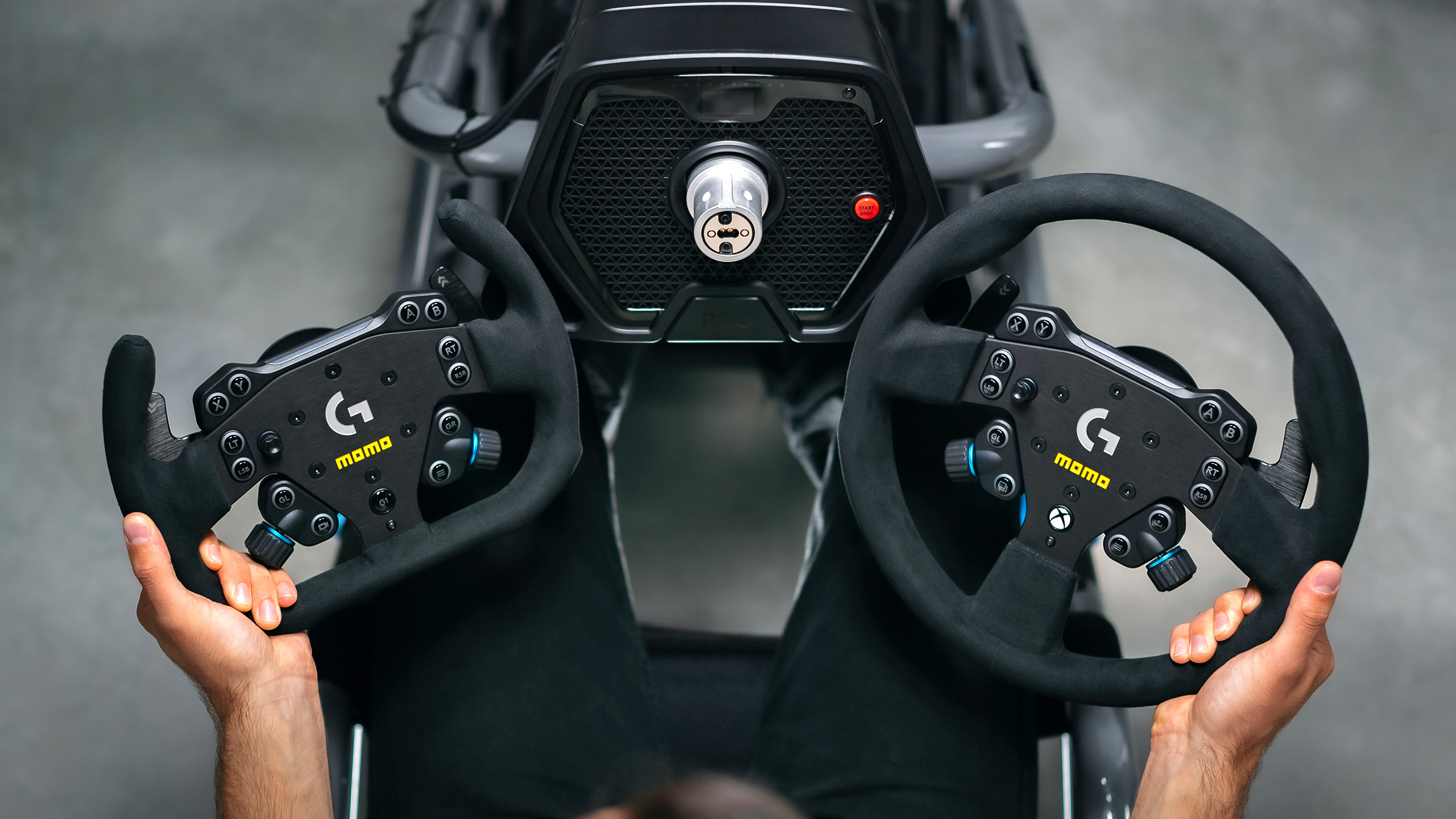

Late in 2022, Logitech launched the G Pro steering wheel and base, its first direct-drive sim racing system ever. The product was good, if expensive at its initial MSRP of $1,000, but Logitech assured us that in time, the G Pro ecosystem would grow to incorporate many more wheel rims and peripherals, so owners would be able to customize their rig to suit the exact type of driving they do. For about two years since, there hadn’t been any additions to the line—though that’s finally changing today.
As part of its Logi Play day of announcements, Logitech has unveiled five new products specifically built for the G Pro base: the RS Shifter & Handbrake ($150), RS Wheel Hub ($130/$150 for added Xbox support), RS Track Wheel and Round Wheel ($70), and RS Quick Release Adapter ($60). To clarify, the RS Wheel Hub is the inner portion of the wheel that connects to the base owners would already have, and the RS Track and Round Wheels are the rims that attach to that inner portion. The separation between those components allows owners to purchase one hub and either rim to fit their needs. Logitech has also announced that the PlayStation-compatible version of the Pro Racing Base will be available standalone, without a wheel, when it was previously only available as part of a bundle.





Compatibility is, unfortunately, a minefield where sim racing hardware is concerned. While everything generally works with PC, Sony and Microsoft have their own requirements, such that accessories purchased to satisfy one console won’t automatically satisfy the other, and it’s headache-inducing. Thankfully, Logitech has attempted to clarify this for customers, by proposing a combination of hardware that it says will guarantee full cross-compatibility: a PlayStation-compatible base with an Xbox-compatible Wheel Hub. That means that, yes, there’s an Xbox-specific version of the Wheel Hub, and it costs $20 more than the standard version that will work with PC and PlayStation.
Hopefully, you got all that, so now we can get to the fun stuff. Logitech says it’s incorporated two critical points of customer feedback into the Wheel Hub. First off, the RGB shift lights are on the hub itself. That certainly makes them more present than the rather small LEDs on the base, which can be easily obscured depending on your seating orientation. Second, the shift paddles on this hub can be extended outward for larger-diameter wheel rims, an absolute necessity for the kind of mixing and matching the company expects its customers to do.



Meanwhile, the RS Shifter & Handbrake are, indeed, one accessory that can satisfy both use cases, when required. The shifter is of course a sequential shifter, meaning that Logitech still doesn’t offer a Pro-grade H-pattern item to replace the toy-like Driving Force Shifter. That said, it is neat that the RS Shifter & Handbrake is a dual-purpose product, and it’s even cooler how they can be stacked atop each other if not side by side, for drifters or rally drivers who want to use both simultaneously. To switch from one purpose to the other, all owners need to do is unscrew the handle from one of the holes in the base and screw it into the other.
What else? Well, that $60 Quick Release adapter will allow you to use your Logitech base with any company’s wheel, provided you’re playing on PC and the wheel in question has an industry-standard bolt pattern and pin interface. And finally, Logitech has partnered with Momo to make a 290-millimeter GT wheel and 320-millimeter round wheel lined in Alcantara-like microfiber, for an even more premium experience. These wheels come off Momo’s Italian production lines, and will each run $200. They’re also set to start shipping a little later than the rest of the line, in January.


That’s plenty to look forward to, then. Still, the question remains: Why has it taken Logitech about 24 months to make good on its promise of an ecosystem of higher-end sim racing gear? Richard Neville, who manages the company’s sim racing portfolio, said it all came down to testing.
“We spend an awful lot of time with reliability testing, it’s so important to us,” Neville said in a roundtable interview. “We look at the number of cycles that are required in the lifetime of a product. That’s gear shifting, steering pedals—everything to do [with what] you’re using in a race. If you start looking at some of the use-case scenarios—like someone who races, say, four hours a day, five days a week, 48 weeks a year, or even more—when you start adding up the number of gear shifts, the number of pedal presses in that time, it’s insane. It really does get to crazy numbers. We want to make sure the product lasts. And we do accelerate—we did aggressive reliability testing. It takes time to hit the number of cycles we want to hit. That is a large, large chunk of what we do in development. Until we’re happy with it, we’re not going to ship the product. And unfortunately, that is one of the major reasons why these products have taken as long as they have.”
Logitech certainly has a reputation for long-lasting quality, particularly for its sim racing equipment, so that emphasis on reliability is understandable—though, arguably the company shouldn’t have teased a line of products a full two years before it was prepared to ship. In any case, sim racers will certainly put all this hardware through the wringer, and test those longevity claims firsthand. Save for those Momo wheels, all of it is available starting today.



Got tips? Send ’em to tips@thedrive.com